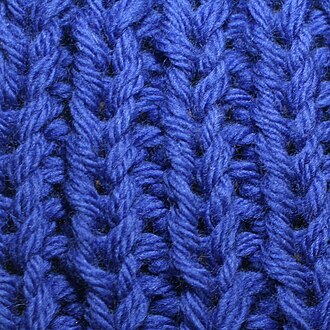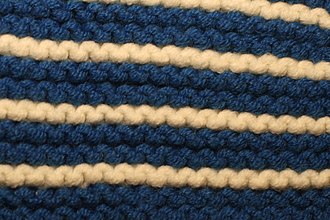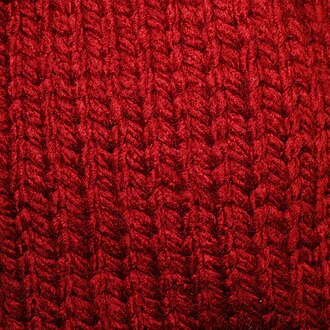Difference between revisions of "AY Honors/Knitting/Answer Key"
(import text from w:Ribbing (knitting)) |
|||
| Line 25: | Line 25: | ||
===c. Cable stitch === | ===c. Cable stitch === | ||
===d. Ribbing === | ===d. Ribbing === | ||
| + | [[File:Ribbing.jpg|thumb|300px|1x1 Ribbing]] | ||
| + | In knitting, ribbing is a pattern in which vertical stripes of stockinette stitch alternate with vertical stripes of reverse stockinette stitch. These two types of stripes may be separated by other stripes in which knit and purl stitches alternate vertically; such plissé stripes add width and depth to ribbing but not more elasticity. | ||
| + | |||
| + | The number of knit and purl stripes (wales) are generally equal, although they need not be. When they are equal, the fabric has no tendency to curl, unlike stockinette stitch. Such ribbing looks the same on both sides and is useful for garments such as scarves. | ||
| + | |||
| + | Ribbing is notated by (number of knit stitches) x (number of purl stitches). Thus, 1x1 ribbing has one knit stitch, followed by one purl stitch, followed by one knit stitch, and so on. | ||
| + | |||
| + | Ribbing has a strong tendency to contract laterally, forming small pleats in which the purl stitches recede and the knit stitches come forward. Thus, ribbing is often used for cuffs, sweater hems and, more generally, any edge that should be form-fitting. The elasticity depends on the number of knit/purl transitions; 1x1 ribbing is more elastic than 2x2 ribbing, etc. However, some cable patterns may "pull in" more than ribbing (i.e., have a smaller gauge); in such cases, a ribbed border may flare out instead of contracting. | ||
| + | |||
| + | Slip stitches may be added to increase the depth of the ribbing, and to accentuate the stitches of certain wales. For example, the knit stitches can be slipped every other row to double their height and make them come forward. | ||
| + | |||
| + | Ribs can be decorated with nearly any motif used for a plain knitted fabric, e.g., bobbles, cables, lace, various colors, and so on. | ||
| + | {{clear}} | ||
| + | |||
===e. Garter stitch=== | ===e. Garter stitch=== | ||
[[File:Garterstitch.jpg|thumb|300px|Garter stitch]] | [[File:Garterstitch.jpg|thumb|300px|Garter stitch]] | ||
Revision as of 04:32, 13 January 2010
1. Define the following:
These abbreviations are a form of shorthand used to describe knitting patterns.
- a. K
- Knit stitch
- b. P
- Purl
- c. STS
- Stitches
- d. RND
- Rounds
- e. TOG
- Together
- f. PSSO
- Pass Slipped Stitch Over
- g. INC
- Increase or Increasing
- h. DEC
- Decrease or Decreasing
- i. YO
- Yarn Over
2. Demonstrate the following:
a. Cast on
The single cast on is probably the easiest to learn, but its a little more difficult to knit evenly with this cast on. The knitted cast on is a little more difficult to learn, but very similar to the knit stitch, and is a little easier to knit evenly from.
Instructional videos of how to do these cast-ons can be found here: http://www.knittinghelp.com/videos/cast-on
b. Bind off
The basic knit and basic purl bind offs (or cast-offs) are the simplest and easiest to learn. Be aware that they do create an edge that is not as stretchy as other bind-offs might.
Videos of how to do the basic knit and purl bind-offs can be found here: http://www.knittinghelp.com/videos/casting-off
c. Cable stitch
d. Ribbing
In knitting, ribbing is a pattern in which vertical stripes of stockinette stitch alternate with vertical stripes of reverse stockinette stitch. These two types of stripes may be separated by other stripes in which knit and purl stitches alternate vertically; such plissé stripes add width and depth to ribbing but not more elasticity.
The number of knit and purl stripes (wales) are generally equal, although they need not be. When they are equal, the fabric has no tendency to curl, unlike stockinette stitch. Such ribbing looks the same on both sides and is useful for garments such as scarves.
Ribbing is notated by (number of knit stitches) x (number of purl stitches). Thus, 1x1 ribbing has one knit stitch, followed by one purl stitch, followed by one knit stitch, and so on.
Ribbing has a strong tendency to contract laterally, forming small pleats in which the purl stitches recede and the knit stitches come forward. Thus, ribbing is often used for cuffs, sweater hems and, more generally, any edge that should be form-fitting. The elasticity depends on the number of knit/purl transitions; 1x1 ribbing is more elastic than 2x2 ribbing, etc. However, some cable patterns may "pull in" more than ribbing (i.e., have a smaller gauge); in such cases, a ribbed border may flare out instead of contracting.
Slip stitches may be added to increase the depth of the ribbing, and to accentuate the stitches of certain wales. For example, the knit stitches can be slipped every other row to double their height and make them come forward.
Ribs can be decorated with nearly any motif used for a plain knitted fabric, e.g., bobbles, cables, lace, various colors, and so on.
e. Garter stitch
Garter stitch is the most basic form of welting (as seen from the right side). In the round, garter stitch is produced by knitting and purling alternate rows. By contrast, in the flat, garter stitch is produced by knitting every stitch (or purling every stitch, though this is much less common).
In garter-stitch fabrics, the "purl" rows stand out from the "knit" rows, which provides the basis for shadow knitting. Garter-stitch fabric has significant lengthwise elasticity and little tendency to curl, due to the symmetry of its faces.
f. Stockinette stitch
Stockinette stitch (in the UK, Stocking Stitch) is the most basic knitted fabric; every stitch (as seen from the right side) is a knit stitch. In the round, stockinette stitch is produced by knitting every stitch; by contrast, in the flat, stockinette stitch is produced by knitting and purling alternate rows.
Stockinette-stitch fabric is very smooth and each column ("wale") resembles a stacked set of "V"'s. It has a strong tendency to curl horizontally and vertically because of the asymmetry of its faces.
Reverse stockinette stitch is produced in the same way as stockinette, except that the purl stitches are done on the right side and the knit stitches on the wrong side. In the round, reverse stockinette stitch is produced by purling every stitch.
g. Pick up a dropped stitch
3. Know how to care for these kinds of yarn:
a. Wool
Wool is sensitive to agitation and hot water, which causes the overlapping scales of the fiber to stick together, what we call shrinking, or, if we do it on purpose, felting.
To avoid this, wools should be washed in lukewarm water with little agitation. Most people prefer to wash wool items by hand to avoid any possibility of felting when they can't see what's happening inside their washing machine.
b. Hair
c. Synthetic
Synthetics are well-suited for the many currently popular novelty yarns, and their range is vast. Manufacturers continually attempt to make synthetic yarns that mimic the best properties of the natural fibers. Synthetics are generally durable, water-resistant, and strong, but can also be somewhat non-breathable and non-insulating. Most are machine washable, but are very sensitive to heat, and they will melt or burn at fairly low temperatures. Nevertheless, knitters can’t help but be drawn to their seductive textures and rich colors.
Polyester: Polyester is made from a group of condensation polymers. It is resilient, smooth, crisp, and springy. It can be shaped with heat and is insensitive to moisture. It is lightweight, strong, and resistant to creasing, shrinking, and stretching. It is nicely washable, and is not damaged by sunlight, weather, moths, or mildew. Polyester is very often combined with other fibers.
Acrylic: Acrylic is a synthetic polymer fabric or yarn, and is lightweight and warm with a very wool-like feel. Although it is resistant to moths, oils, and chemicals, it is prone to static and pilling. 100% acrylic yarns can be a bit “cheap-looking,” if not chosen with care.
Nylon: Nylon was the first completely synthetic fiber. It is strong and resistant to many chemicals and moths. It is also easy to wash and is very non-absorbent. It can be a bit scratchy if not blended with another fiber.
Viscose / Rayon: Viscose is a man-made fiber made of wood or cotton cellulose treated with sodium hydroxide to make a liquid that can be extruded as cellophane or rayon yarn. Rayon fiber is quite absorbent, dyes very well, is soft, and has a nice drape. Although it may shrink, it does not melt at high temperatures, and it is resistant to moths, bleach, and many common household chemicals. Rayon thread is divisible, shiny, and good for blending, but is not hard wearing.
4. Show how to join on a new ball of yarn.
5. Identify and know the purpose of the following weights of yarn:
a. Medium
Worsted Weight (also called Afghan or Aran) yarn is a medium weight yarn that is used for a wide range of projects. Thick adult sized clothing (such as sweaters, gloves, scarves, etc.) and home items (such as pillows, afghans, blankets, dishcloths, etc.)are customarily made from worsted weight yarn. Worsted weight is used when items should be relatively durable, and thick, but not bulky. Needle sizes 7-9 are recommended for use with worsted weight yarn, with a gauge of 4-5 stitches per inch in stockinette stitch.
b. Sports
Sport weight (also called heavy baby weight, or fine) yarn is used to create objects with a little more weight than sock yarn, but lighter weight than DK yarn. Baby clothing, light mittens, and light blankets are examples of items usually knit from sport weight yarn. The recommended needle size for sport weight yarn is 1-3, with a gauge of 7-8 stitches per inch in stockinette stitch.
c. Heavy
Chunky also called craft, or rug weight) is a heavy/bulky weight yarn (not to be confused with Bulky, or Roving, which is a super bulky weight yarn). It is a thick yarn that works up quickly on large needles, so if you don't have hours to spend on a new scarf, this is a good choice for something thick and warm, but also fast. It can also be used to make a quick throw or blanket.
Needle size: US 9 - 11 (5.5mm - 8mm)
Hook size: US K10 1/3 - M13 (6.5mm - 9mm)
d. Super Bulky
Bulky or Roving, is a super bulky weight yarn used for extremely thick, very quickly knitted objects, such as very heavy hats, coats and scarves. It is recommended that objects knitted in roving are done with needles sized 11 or greater, with a standard gauge of 1.5 - 2 stitches per inch.
6. Knit two items from the following:
a. Slippers
b. Mittens
c. Baby booties
d. Hat
e. Scarf
A scarf is perhaps the simplest knitting project possible. If super bulky yarn is used with 25mm needles, the scarf can be knitted quickly which helps to abate any patience problems your Pathfinders might have.
- Start by casting on 12 stitches.
- Knit every row (forming a garter stitch) until the scarf's length exceeds the knitter's patience.
- Bind off.
f. Sleeveless sweater
g. Reasonable choice
One reasonable choice would be a pair of leg warmers.



